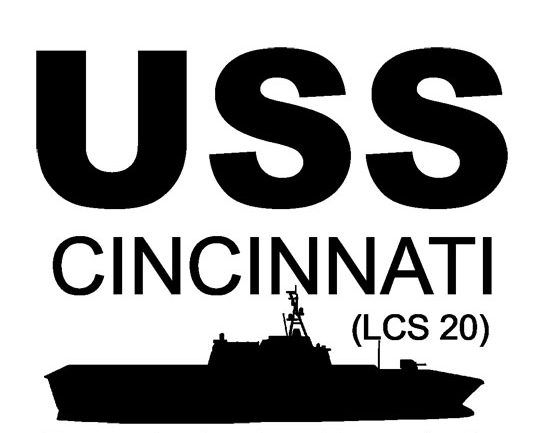Our Ship


Littoral Combat Ships
What is a Littoral Combat Ship?
A Littoral Combat Ship, or LCS, is a fast, agile, mission-focused- platform designed for operation in near-shore environments yet capable of open-ocean operation. It is designed to defeat asymmetric “anti-access” threats such as mines, quiet diesel submarines and fast-surface craft.
This tri-hull “Independence” variant is the 20th ship of the class and is powered by two LM2500 gas turbine engines built by GE Aviation. In fact, Cincinnati’s own GE Aviation builds the engines for every ship in the class and has delivered gas turbines on board 646 naval ships serving 35 navies worldwide.
These ships represent the next generation of Navy combatants with modular mission payloads, high speed, and automation enabled shipboard operation.

Want to learn more?
The LCS class consists of two variants, the Freedom variant and the Independence variant, designed and built by two industry teams. The Freedom variant team is led by Lockheed Martin (for the odd-numbered hulls, e.g. LCS 1). It is a steel monohull design constructed by Lockheed Martin in the Fincantieri Marinette Marine Corporation’s shipyard in Marinette, Wisconsin. The Independence variant is an aluminum trimaran design originally built by an industry team led by General Dynamics Bath Iron Works for LCS 2 and LCS 4. Currently, Independence variant LCS (LCS 6 and subsequent even-numbered hulls) are constructed by Austal USA in the company’s Mobile, Alabama, shipyard.
LCSs are outfitted with mission packages (made up of mission systems and support equipment) that deploy manned and unmanned vehicles and sensors in support of mine countermeasures, anti-submarine warfare or surface warfare missions.
Maintenance
Unlike most surface ships, traditional crew level maintenance for LCS is pushed ashore and corrective maintenance is performed using distance support and fly-away teams. The LCS sustainment strategy calls for frequent maintenance periods as part of the ship’s operational schedule – normally five days per month for standard preventive maintenance and quarterly for more significant corrective maintenance. Much of the work accomplished during these planned maintenance availabilities (PMAVs) and continuous maintenance availabilities (CMAVs) is conducted by contracted U.S.-based maintenance teams. Support for deployed hulls is accomplished with tailored fly-away teams of U.S. contractors.
Crewing
LCS is moving toward a Blue/Gold crew model which alternate manning the ship. This concept creates six divisions (three per coast) comprised of four ships of the same variant – including one as a dedicated training ship, which will be manned by a traditional, single crew vice rotating crews. The training ship in each division will remain in the United States and operate in local areas to certify the six Blue/Gold crews that will operate the three deployed LCSs of each division. Each division will have a single warfare focus (surface warfare, anti-submarine warfare or mine warfare); the ship core crews and mission module detachments will be fused. This approach provides more forward presence with a better blend of ownership, stability, and increased training for each crew, while the divisions have improved oversight and reinforcement of the mission focus.
Testing
The first four ships of the LCS class- two of each variant- have been designated “test ships” to support the mission modules through Initial Operational Capability (IOC) testing. These ships will be dedicated to execute mission module test and evaluation, as new systems are procured or designed prior to deployment. While deployable, they are not expected to deploy until known mission modules achieve IOC later this decade.
Training
A key enabler of LCS rotational crewing is the LCS shore-based training and certification capability, which represents a significant advancement in the surface force approach to qualification of individual watchstanders and teams. Crew training is based on a virtual ship-centric concept, accomplished through a combination of classroom instruction, vendor training, shore-based trainers and sophisticated virtual reality training systems. This ensures LCS ships deploy with fully qualified sailors, a ship Key Performance Parameter, without hindering their ability to be adequately trained, as well as ensuring time spent on LCS is time operating LCS.
Information pulled from the U.S. Navy Fact File.
General Characteristics
| Class and type | independence-class littoral combat ship |
| Displacement | 2,307 metric tons light, 3,104 metric tons full, 797 metric tons deadweight |
| Length | 127.4 m (418 ft) |
| Beam | 31.6 m (104 ft) |
| Draft | 14 ft (4.27 m) |
| Propulsion | 2x gas turbines, 2x diesel, 4x waterjets, retractable Azimuth thruster, 4x diesel generators |
| Speed | 40 knots (74 km/h; 46 mph)+, 47 knots (54 mph; 87 km/h) sprint |
| Range | 4,300 nautical miles (8,000 km; 4,900 mi) at 20 knots (37 km/h; 23 mph)+ |
| Capacity | 210 tonnes |
| Complement | 40 core crew (8 officers, 32 enlisted) plus up to 35 mission crew |
| Sensors and processing systems | Sea Giraffe 3D Surface/Air RADAR Bridgemaster-E Navigational RADAR AN/KAX-2 EO/IR sensor for GFC |
| Electronic warfare & decoys | 4x SRBOC rapid bloom chaff launchers |
| Armament | BAE Systems Mk 110 57 mm gun 4x .50 cal (12.7 mm) guns (2 aft, 2 forward) Evolved SeaRAM 11 cell missile launcher Mission modules |
| Aircraft carried | 2x MH-60R/S Seahawks MQ-8 Fire Scout |

Upcoming Events
Get involved and make a difference with us!
No Events Found...
Subscribe Now!
Stay updated on our latest events and information.


